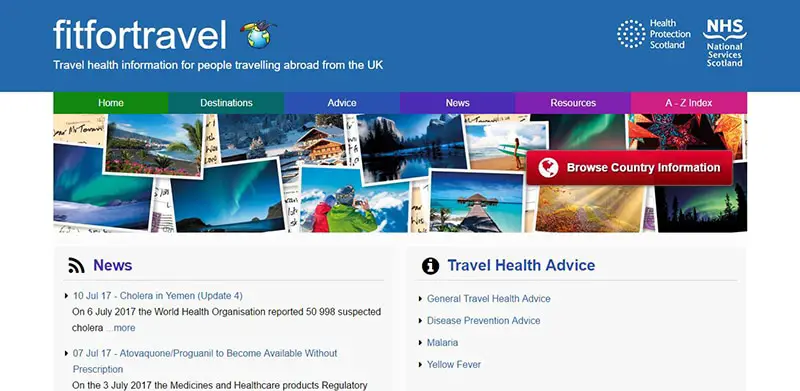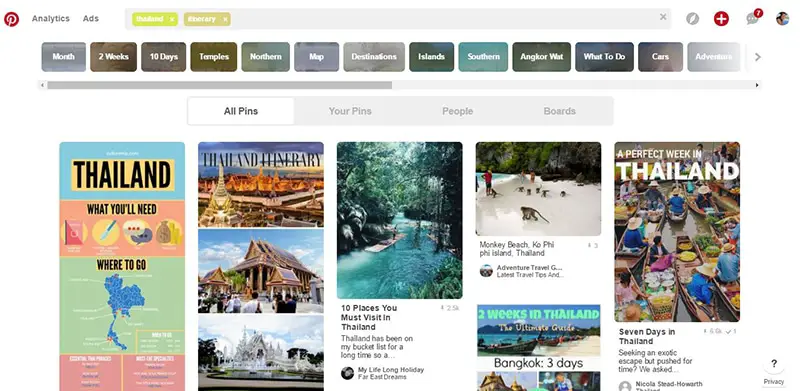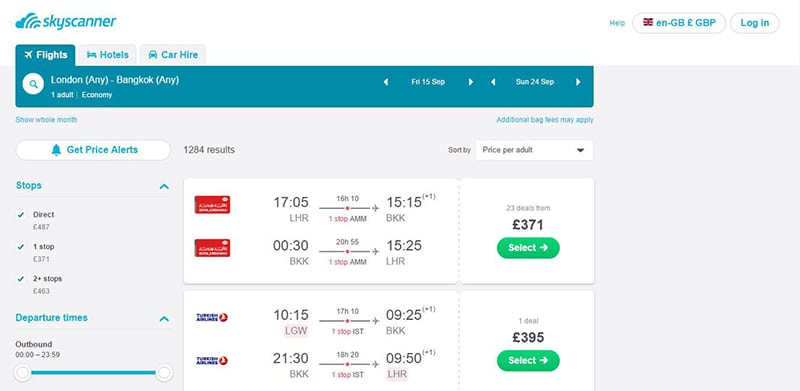Some people swear that traveling with no plan – other than buying a one-way plane ticket – is the only way to experience a country authentically. But if you’ve landed on this website my guess is that you’re interested in being a little more organised than that.
You probably prefer to have a plan. You feel more comfortable knowing where you will be resting your head every night, at what time the train or plane leaves for your next destination, and what the main things to see and do are in each place.
Knowing all of these things means you need to create a travel itinerary for your trip. A daily outline that ensures your trip runs smoothly and that you can, therefore, make the most of your precious time. By investing the time now to put together an itinerary, you save time for more fun things whilst you are abroad.
This blog features travel itineraries for destinations around the globe. I created all of them myself and I will show you how you can do this yourself for any country you would like to visit. The length of your trip really doesn’t matter. The process remains the same whether you are planning a weekend getaway in Europe, three days in New York City, a two-week road-trip around central america, a three-week round trip around South East Asia, a month discovering the middle east or a year long adventure in south america.
You could, of course, get a travel agent to do the travel planning for you, but you will without a doubt pay far more for your trip than you would have done had you planned it yourself. There are also plenty of apps and websites that will help you plan your trip. But I personally find that doing it yourself will afford you far more flexibility.
Whilst planning your own itinerary requires a certain level of skill and practice, especially for more complex ones, I am convinced anyone can do it. The key to any well-laid-out travel itinerary is to start planning it early and to retain a certain amount of flexibility.
1. DECIDE WHAT THE LENGTH OF YOUR TRIP SHOULD BE
The duration of your trip is a crucial factor in the planning process. You will not be able to determine the cost of a trip and whether you can afford it until you have decided how long you are going away for.
Are you going for a week? A couple of weeks? A month? A year? Figure out your total number of days and go from there.
To a certain degree, this will be determined by the amount of leave your work grants you. To give you a rough idea, Gary and I tend to go on one sixteen-day-long adventure abroad every year. By starting our trip on a weekend and ending it on a Sunday, we use up around ten days of leave. Because we both have twenty-one days of leave in total, this means we retain eleven days for smaller three or five-day trips around the UK and Europe.
So it is worth starting your itinerary planning process by figuring out how many days leave you have or can afford to take off, before doing anything else.

2. ESTABLISH A BUDGET
Make sure to set yourself a realistic budget early on. This will influence what destination you choose, what flights and hotels you book, and how many places you can visit. You do not want to plan a fabulous itinerary and then discover you cannot afford it.
Ask yourself “how much can I realistically spend on this trip”. How much spare money do you have now and how much can you save up by the time you book your flights and hotel? Consider asking friends and family to contribute to your travel budget, in lieu of a gift for your birthday and Christmas.
Unfortunately, some adventures (like skydiving in New Zealand or scuba diving in Iceland) might over-exceed the amount of money you have in your pocket. When going back and forth, remember to ask yourself if there something you literally would go crazy regretting if you didn’t go do it if you had the chance. If choosing to save money by not going to your grandfather’s hometown would keep you up at night, maybe it’s worth penny-pinching elsewhere.
There are of course many ways you can get more for your buck. You could travel in the shoulder season or off-season, scour the market for cheap deals on flights and hotels and shorten your trip.
If you are looking for additional ways to stretch your travel budget, consider signing up for a Travel Credit Card. Many of these cards offer rewards such as cashback, points, and airline miles that can be used towards travel expenses. Some cards also offer free travel benefits such as travel insurance, lounge access, and waived foreign transaction fees. Make sure to do your research and compare the different cards available to find the one that best suits your travel needs and spending habits. Additionally, be sure to use the card responsibly and pay off the balance in full each month to avoid accruing interest charges.
To find out more about the typical cost of visiting a particular country try using the website Budget your Trip.
You should also check what currency is typically used in the country of your choice (some countries have multiple currencies) and what the current exchange rate is. A great way to save money is to choose a destination where the exchange rate puts you in an advantageous position. The XE Travel App is a great resource to check current exchange rates.
3. CHOOSE A DESTINATION
Now that you have set a budget and timeline, you can choose a destination.
If you are anything like me you have a really long wish list. Is there a particular site or activity that ranks high on this must-see travel list? You could plan an entire trip around that. One year Gary and I visited Iceland with the sole intention of seeing the Northern Lights.
To get started, try daydreaming big and brainstorming ideas such as countries or cities to visit, famous landmarks to see, events to attend, unique activities to try, volunteering opportunities, and even friends or family to visit.
If this is your first time traveling and you do not yet have a bucket list then visit a couple of blogs, browse through Instagram and buy some travel magazines for inspiration. What takes your fancy? Is there anything that screams out to you?
Certain destinations are particularly suited for a specific season– like Christmas in New York, New Years’ in Sydney, or seeing the spring cherry blossoms in Japan.
If you have a country or city in mind, it’s worth a quick check to see if there’s anything exciting happening at a particular time of year that could make your trip even better. Are there any festivals you would like to see or participate in?
Do consider whether a country might be particularly crowded at that time though. Prices for hotels and flights increase in peak season.
Finally don’t forget to check the weather forecast. You really don’t want to spend your whole holiday in the rain. (Unless that is your thing of course. I am singing in the rain…)

4. CONSIDER ANY DOCUMENTATION AND VACCINATIONS YOU MIGHT REQUIRE
If you do not have the required documentation and vaccinations for your chosen destination, you are not only endangering yourself, you might not even make it into the country in the first place.
So before you start planning your itinerary and certainly before you book anything, try and find out what documentation and vaccinations you will need, how far in advance you have to start the process of getting them, and how much it will cost to do so. You might find that their cost doesn’t fit into your budget or that you have left it too late.
Most people have a passport, but if you do not, remember that it can take at least four to six weeks from the time of application for you to receive one. You can, of course, pay extra to shorten the process, but it would be far better to spend that money on the actual trip. If you do have a passport, you might want to check its expiration date. You really do not want to find out your passport is out of date at the airport. Other common requirements include having your passport in decent condition, a passport valid for a certain length of time after your stay, and enough free pages in your passport.
Do some research to find out if you are going to need a tourist visa. And if you are planning a longer trip (maybe you are doing a tour of the world), then you might want to apply for a working visa. These are quite flexible and usually valid for a year or two.
If you are planning to hire a car, remember that you will require a valid license in your home country. So check the expiration date on your license. Note that some countries require an international driving permit and that in others you might be too young to hire a car.
The foreign office site is also the best place to check in on general safety in the country you plan to visit and any concerns regarding tourism to be aware of, including any ‘no-go’ zones. It’s worth being aware of these as many travel insurance policies are invalidated if incidents take place in areas you’re advised not to visit.
For certain destinations, you will need to get a considerable amount of vaccinations and medicine (Africa is just one example). And certain countries require proof that you received these vaccinations. The website NHS Fit to Travel will help you determine what types of vaccination you need. It is also worth making an appointment with a travel clinic before your trip if you’re visiting a destination where vaccines are required or just for your own peace of mind
5. FIND AFFORDABLE FLIGHTS
Often flights to and from a destination are going to be the biggest expense so the first thing I tend to check is whether the costs of getting there will be realistic. Flights can be very expensive for one location and far cheaper for another. So before you fully settle on a destination, check what flights are available and how much they will roughly cost. We like to use Kayak Explore or Skyscanner Everywhere (just type “everywhere” into the destination field) for this purpose.
Are there affordable flights from your local airport? Or do you need to travel to a bigger city first? Will there be a layover? And where does the flight land?
This research will not only determine your departure point, it will also set the arrival point in your chosen destination and consequently the beginning of your itinerary. You could even save money by flying to one airport over another.
When I was planning our trip to Japan, for instance, I had to decide whether we would start our holiday in Tokyo or Kyoto. The flights were considerably cheaper to Tokyo and so our choice was obvious.
Finally, your choice of flight will narrow down your holiday to specific dates. Are you leaving on the weekend or midweek? Midweek flights are generally cheaper but also mean you need to take more days off work.

6. CREATE A SCHEMATIC OUTLINE OF YOUR TRIP
Don’t book your flights just yet. Even if you are tempted by a special offer. And even if that offer is time-sensitive. Create a rough outline of your itinerary first. Once you know where you’re going, when you’re heading there, and how much it will cost, the next step is to plan your route through the country.
Will you be staying in the same location for the duration of your trip or are you wanting to visit several cities/regions/countries whilst you are there? When Gary and I plan a two-week trip we always aim to get a good overview of the country and its various regions. Rarely do we stay in the same place for more than three days. But that is our particular travel style. What is yours? Do you suffer from FOMO as we do?
To help you create a rough outline of your trip, you might want to visit the following three websites:
- Pinterest: just search for the country you are planning to visit. Typically lots of pins leading to suggested itineraries and places to visit will pop up. Create a board and pick out the top places you like the look of. There is no point in reinventing the wheel.
- Instagram: Type #country into the search bar to find loads of inspiring images and places you’ll definitely want to visit
- Trip Advisor: This website has created guides of The Top Things to Do for almost every destination. Whilst these are generally based on overall consensus and often do not match up with our own travel style, it is nonetheless worth taking a look at these guides to make sure you haven’t missed anything
Decide what cities/regions/countries you absolutely need to visit. Figure out which ones you have the time and budget to get to. Now determine how much time you will spend in each place.
7. FIND HOTELS FOR EVERY CITY OR AREA YOU ARE PLANNING TO STAY IN
Your next step is to find a hotel that fits your budget for each city/ region/ country that you are planning to visit. You do not want to create a detailed itinerary before you know for certain that you can afford accommodation in each location.
You could of course simply book a room at the local Hilton and be done with it. But I would suggest that you do a little more research than that. You never know you could find some really interesting lodgings that are almost as exciting as the attractions you are planning to visit. Keep your eyes open for historic castles, tiny bed and breakfasts, houseboats, eco-friendly hotels, or organic farms. Budget travellers take note: Vacation rentals, homestays, farm stays, and house-swapping are accommodation options that can be shockingly affordable … or even free. My favourite search engine for finding a place to stay is booking.com, because it includes brand hotels, small hotels as well as guesthouses and B&Bs.
I also always check reviews for the hotels I have in mind. My go-to website for this is TripAdvisor. Look at the average amount of reviews in each category. If the majority of reviews are excellent or good this is a good sign. Next check the terrible and poor reviews. Most of these you can ignore, however, there might be a reoccurring theme. Finally, read some of the good and average reviews. These are generally the most honest ones. I also try and find any blog reviews of the hotel (Type the name of the hotel into the search bar + blog review). Blog reviews generally have the best “unaltered” pictures.

8. DETERMINE HOW YOU WILL TRAVEL FROM ONE PLACE TO THE NEXT AND HOW LONG THIS WILL TAKE YOU
After you have created a rough itinerary and checked that you can afford accommodation in each place you want to visit, you will need to determine how to travel from one area to another.
Pop all your chosen destinations into Google Maps to determine how close to one another they are located. This will also allow you to make any amendments to the chronology of your itinerary if needed.
The size and proximity of each location should also help you determine which places to base yourself in and which places you can travel to and from in a day trip. Gary and I, for instance, were based in Tokyo when we visited both Hakone and Kamakura. And we were staying in Kyoto when we visited Nara.
You will need to determine how long it will take to travel from one location to another and what the best means of transport will be. Not only will this affect your budget (you might need to prioritise one location other another), it will also inform you of how much time you should spend in each location. In my experience places can look misleadingly close to one another on the map, but on further inspection take many hours to travel between.
My favourite website for this type of research is Rome2Rio. Just type in both locations and the website will bring up various options (with associated costs) on how to get from one place to another by public transport or by car. You can also check travel forums for advice from other travels. Just beware travel advice from 2009 might be slightly out of date!
Your means of transport will vary from one country to another. In Japan, the quickest and most affordable way to travel from one city to another was by bullet train. And we were in luck because Japan issues special Railpasses for tourists, which make train travel relatively affordable. In contrast, in Thailand, the cheapest way to travel from one city to another was by hopping on an internal flight.
In certain countries, a rental car might be your best bet, especially if you’re travelling to locales that can’t be easily reached by rail or plane (such as the Irish countryside). Be mentally prepared to drive in a foreign country, which can be a frightening experience when faced with incomprehensible traffic signs, narrow streets or sheep roadblocks.
Incorporating walking tours, bike tours, camping and adventure tours is another interesting option of getting from one place to another worth considering.
If travelling from one place to another means you need to change transport several times, make sure you have those schedules organised with military precision. Whether you’re taking a plane, train or automobile — always leave yourself more than enough time to get where you need to be and have all of your arrival and departure times saved in several different, easily accessible locations.
And don’t forget to download the apps for the local public transportation systems — they will make your trip so much easier.
9. FIND SITES AND ACTIVITIES, GROUP THEM BY AREA AND START FILLING OUT YOUR TRAVEL ITINERARY
Your itinerary is slowly starting to take shape, but now it is time to fill it out in more detail. Once you know what places you will be visiting and how long it will take you to get from one place to another, you can fill the rest of your itinerary with exciting activities and sites to visit.
Creating a detailed trip itinerary for your dream vacation can be as simple as writing down everything you know about your destination in a travel notebook. Jot down the places you want to see, activities you want to try, and things you want to do.
Visit Pinterest, Instagram, Tripadvisor, and Like A Local, to get a list of all the key attractions you want to see.
Your list doesn’t have to be limited to popular tourist spots though, focus on anything that sparks your interest. Local cooking classes can be fun or perhaps you would like to learn a craft from that area.
I even tend to jot down restaurants that take my fancy. Furthermore, I like to find unique tours of an area or city. GetYourGuide is a great resource for this.
I always recommend checking multiple sources. This is a great way to cross-examine whether somewhere is genuinely worth visiting or an overhyped tourist trap. And don’t forget to ask friends who have traveled to the same country. They know what you will enjoy the most.
Once you have your list, you can start to figure out if it’s realistic and doable within your timeframe.
Prioritise your list of activities and sites based on your itinerary, budget, and how much time you have.
Repeat step 8 (above) for every area or city you want to visit.
Then start filling out each day of the itinerary with things to do in the morning, afternoon, and evening. Note that in order to save time and unnecessary costs, I like to group sites and activities by proximity. During this process, I also tend to create a more precise budget. In my itineraries, I like to include a rough daily cost of transport, food, accommodation, tours, day trips, entry fees, and spare spending money. This ensures that I do not arrive somewhere, realise I have massively underestimated the cost, and am going to have to count the pennies for the entire trip. It put my mind at rest but might feel a little OCD for others.

10. BOOK YOUR FLIGHTS
Because airfare is generally the most expensive part of your trip, as well as the most time-sensitive, you will want to book your flights first. Book your flights before you book your hotels. You need to remain flexible with the dates. There might be a special offer too good to ignore.
Don’t book your flight directly with the flight company. Shop around. There are many websites that offer flights at a reduced cost. In fact, I often book my flights, together with the hotel we are staying at the longest, through Expedia. Their package deal often saves me a lot of money. Another one of my go-to websites is Skyscanner. Their prices for flights are generally unbeatable. Other good flight search engines include Kayak and momondoMomondo.
There are a ton of guides written by other bloggers on how to secure the cheapest price for flights. These are a couple of my favourites:
- http://thriftynomads.com/booking-cheapest-flight-possible-anywhere/
- http://www.nomadicmatt.com/travel-tips/how-to-find-a-cheap-flight/
- http://www.neverendingfootsteps.com/how-to-find-cheap-flights-around-the-world/
11. BOOK YOUR HOTEL(S)
Next, you should book your hotel(s). As is the case with pretty much everything you book for your trip, the earlier you make arrangements, the better — especially during high season.
Go back to the list of hotels you made previously for each location in your itinerary. Do check however if there are any special offers that day before you book anything. These deals change on a weekly and sometimes daily basis.
Shop around. Do not book your room directly through the contact form of the hotel. There are plenty of websites that offer far better deals. If you are planning a trip in the UK or Europe I would personally suggest you book the room through Expedia or Booking.com . However, if you are traveling to Asia you might be better served by Agoda.
12. CONSIDER BOOKING LOCAL TRANSPORTATION AND ACTIVITIES
You might also want to consider booking local transport ahead of time. Especially if you are planning to use internal flights or need a rail pass.
Whether you book tours and entry to certain attractions before your trip, really is based on common sense. Are you planning to visit the attractions in high season or is there a risk that the tour might be booked out by the time you get there? As a rule of thumb, Gary and I have found that securing local transport almost always saves us money, whilst waiting to book tours until we are in the country allows us to negotiate on the price.
Really it also depends on how happy you are to leave certain things up to chance. I feel a lot less stressed if I know my accommodation, flights and local transport have been booked. On the other hand, I feel less stressed about not making it on a certain tour and am happy to remain a little flexible.

13. THINK ABOUT CONNECTIVITY IN YOUR CHOSEN DESTINATION
Most of us (and that includes me) are glued to our phones. But texting, making calls and browsing the internet can be very expensive when you are abroad. Of course, hotels often offer free internet, but that still means that you will be without a means of communication for most of the day.
Does your cell phone plan allow you to make calls overseas, and if so, how much will it cost you? Thankfully there are many cheap alternatives to roaming. Many cell phone companies offer temporary international plans that you can purchase for the month you’re travelling. While you may be tempted to leave the phone at home and really “get away from it all,” it’s smart to have an emergency phone with you if you’ll be travelling by car, or hiking or biking long distances.
Gary and I almost always get some type of rental pocket wifi. This is a small device that holds a sim card. In effect, it is a wireless modem with a private network that connects with WiFi-enabled devices to the internet. Think of it as a Wi-Fi hotspot, but the difference is that you can bring it with you. One of our favourite rental companies for pocket wifi is TEP Wifi
Other travellers prefer to swap their mobile’s sim card for a local one. To do this you need to ensure that your mobile phone is unlocked and that it is compatible with the sim cards of that country.
here are some additional tips on how to prepare your mobile device before taking a trip.
14. CONSIDER GETTING TRAVEL INSURANCE
It is always a good idea to get travel insurance, especially if you are travelling far away. You never know what might happen and I like to be prepared for all eventualities.
There are several kinds of travel insurance you might want to consider: trip cancellation insurance, flight cancellation insurance, medical insurance, etc.
The best time to buy any type of travel insurance is right after you booked your flights and prepaid for your hotels. At this point, you know how much you have spent and what sum you need to ensure if you choose to do so.
Many airlines offer insurance as an add-on. However, always make sure to read the fine print on the airline’s policies and to compare with other travel insurance policies before you make your purchase. Through experience, Gary and I have found that insurance policies offered as an add-on do not tend to be quite as comprehensive as travel insurance bought through specialist providers.
Check your medical insurance coverage to see if you’re covered overseas. If not, you may want to purchase supplemental medical insurance to cover situations like the cost of transportation back home for emergency care.
15. GET YOUR DOCUMENTATION IN ORDER
Once everything is booked, it’s a good idea to keep all of those details, booking confirmations, and tickets in one place. Personally, I feel more comfortable when I over-prepare. In addition to having an Excel and Word file with all of my info, I also like to keep the hard-copies.
You never know when technology could fail you. So I have a travel wallet that holds everything I could need — transport tickets, public transport cards, foreign currency, booking confirmations, Sim cards, passport, visa.
There are also apps such as Google Trips and TripIt that can help you keep everything in one place. Some airlines, such as Qantas, are also offering similar app services. If you’re looking for something a little lower key, such as simple itinerary apps, you might want to try something like Trip Planner.

16. CREATE A PACKING LIST
Avoid packing the day before your trip. Instead, make a packing list and think about what you need to bring, at least a week in advance. It is more than likely that you will need to purchase a couple of additional accessories, such as a raincoat, suntan lotion or mosquito spray.
You might even need to reconsider what luggage you are taking. Are you going an adventure trip, perhaps you need a backpack? Check your suitcase. Re its wheels still working, does it fit into the airline’s size policies, and is it big enough?
The chance that you forget to pack something essential increases the longer you put off packing. So start thinking of it sooner rather than later.
If you are travelling with your kids, this is a great time to teach them how to pack their own luggage – a very valuable life skill.
17. DETERMINE HOW TO GET TO YOUR DEPARTURE AIRPORT
Depending on how far away you live from your nearest airport, you might need to plan on how to get there.
While driving to the airport is always an option, parking fees for an extended trip can be very expensive. Some airports offer economy parking of course. If you are thinking of going down this route, do check how long it takes to get from the park and ride to the actual airport. Allow yourself plenty of time to check-in and to get through security to avoid stress. Do factor in the fact that you might miss the shuttle and will need to wait for the next one.
If you live in London, you will probably be hopping on public transport. Check that all the tubes are running the night before and leave yourself plenty of room for unplanned closures.
If you are flying early in the morning you might need to take a cab. It’s often cheaper to pre-book a minicab or Uber. Do this a couple of nights before your departure date.
You might also want to think about how you are going to get from the arrival airport to your hotel. Plan this before you leave, it will save you from experiencing a lot of stress when your plane lands. Whilst you can often save money by flying to a more out-of-the-way airport, do weigh up thrift against travel time and inconvenience. Sometimes it is worth paying a little more.
18. READ UP ON CUSTOMS AND SCAMS IN THE COUNTRY
After our itinerary is planned and all the paperwork is in order, I like to read up on particular customs in the country, as well as scams.
For instance, in order to visit temples in Thailand, tourists need to be suitably dressed. Knowing that Thailand is a hot country, I made sure to pack light trousers that nonetheless covered up my legs. Furthermore, in Japan, noise on public transport is frowned upon. Gary and I came prepared with books that we could read on the hour long journey.
It is also a good idea to read up on scams. Most countries have re-occurring scams that most tourists fall for. Some of these scams might inconvenience you, whilst other will leave you high and dry. Best to be prepared and recognise a scam when it comes at you.

19. CONSIDER EXPANDING YOUR VOCABULARY
I always make a point of learning a couple of words in the native language of the country I am visiting. Not only does this reduce potential stress, through experience I have found that locals are generally friendlier if you try and engage with them in their own language.
Think about which words you’ll be using most on a daily basis during your trip and focus on learning those. A good starting point is:
- Hello and Goodbye
- Thank you
- No, and Yes
- 1, 2 , 3, 4 , 5
- How are you
- My name is
- I am from …
- Where is …
- Toilet
- I only speak a little (insert language)
- Another beer, please
If you have any special requirements, it is also worthwhile learning how to express those. Are you a vegetarian? Gluten-Free? Do you have any allergies? Do you take prescription drugs?
I would also advise that you buy a little translation book. Keep this on hand and it might help get you out of a sticky situation.
Finally, if you are ready to dive a little deeper, Babbel is my favourite website to learn a new language
20. TACKLE LAST MINUTE LOGISTICS
You are not quite done yet, there are still a few things that need taking care of.
A few weeks before your departure date think about getting your money exchanged, hiring a house-sitter, or even a pet-sitter (if you need one). I generally ask a friend or a colleague to pop into our flat and check on the fish, when we are gone for longer than a week.
You should also call your credit card company to let them know that you are going to be travelling abroad. You wouldn’t want them to block your card whilst you are in a different country. Whilst you are at it, you could also ask them if you are going to be charged a fee for using your card overseas. It is also a good idea to research the location and availability of ATMs in your destination. In Japan, for instance, only ATMs in 9/11 take European cards and Japanese society is still very reliant on cash.
21. ENJOY THE TRIP AND REMAIN FLEXIBLE


Being organised is great, it will reduce your stress levels and will allow you to fully enjoy the destination. As the old saying goes, failing to plan is planning to fail.
However, one of our biggest travel tips is to avoid planning everything down to the last detail. A little bit of flexibility adds spice to any itinerary. Sometimes our most memorable experiences are those that were utterly unplanned.
Trust me, I am a control freak. And I know that it can be difficult to let go. But remember your itinerary is not a binding contract. It is a rough draft, an outline of your holiday. Things will go wrong. Restaurants and attractions might be unexpectedly closed. You might miss your bus and your flight could be delayed. Your partner might get sick. Don’t let this stress you out, instead be prepared for a bit of spontaneity.
It is always a good idea to leave a little room in your itinerary for exploration. It is likely that you will hear about an attraction you didn’t know about, whilst you are on holidays. You might even find yourself wanting to stay a little longer in a certain place. Get off the beaten track, explore the side streets and eat what the locals do. This is the best way to transform yourself from a tourist into a traveller. After all, isn’t experiencing something new what travel is all about
PLANNING A TRIP
BOOK YOUR FLIGHTS
Book your flight now through one of our favourite search engines. We love all three of these because they search the entire web for the best prices and deals. Alternatively, book your flight and hotel in a package directly with Expedia, this could be the cheapest option.
BOOK YOUR ACCOMMODATION
Check out the latest hotel prices in Germany right now. Our personal favourite hotel booking website for Europe, is Booking.com, since they consistently return the cheapest rate for hotels and guesthouses. Expedia is another good option if you are planning to book your hotel in a package with your flight and car.
BOOK YOUR ACTIVITIES AND TOURS
We like to use GetYourGuide to book our activities and tours, ahead of arrival at a destination. This means that we can skip the queue and save time at our destination.
DON’T TAKE OUR WORD FOR IT!
We like to read the reviews before booking a hotel or including a restaurant or attraction in our itinerary. And in our opinion the best place to find independent reviews is:
PLEASE NOTE: This post contains affiliate links, which means that if you click on some of the links in this post and purchase something, we might receive a commission. This is a good thing! There is no additional cost to you and we make a tiny bit of money to help fund this website!
PLANNING A TRIP?
HERE ARE SOME OTHER POSTS YOU MIGHT FIND INTERESTING.
Do you prefer to plan your own travel itinerary?
Share your best tips in the comments below!
Did you Enjoy this article?
Share it with your friends and family on FACEBOOK, TWITTER AND PINTEREST






Your words evoke an expanse of emotions. Your unique insights add color to the discussion. Thank you for sharing your thoughts and contributing to this vibrant exchange.
Granted, there are countries and regions that require one to be vaccinated prior to entry. However, singling out “Africa” is perpetuating the old, out-dated, and downright offensive idea that Africa is uncivilised and a cesspool of disease. Having travelled to a number of African countries myself, I enjoyed unforgettable scenery, the most opulent hotels and resorts and warmth from all of the locals. We need to be more mindful and sensitive in how we portray developing lands.
Thank you Phoebie for your comment. I agree with you that there are many African countries that are definitely worth visiting. In fact my trips to Namibia and Kenya were some of the most memorable ones in my life.
That being said I don’t see anything wrong with pointing out that you should get additional vaccinations before you visit. This does not in anyway insinuate that African countries are “cesspools of disease” (in your words. But a European might encounter diseases in these countries that they haven’t been previously vaccinated for and being foreign are more susceptible to. As I said Africa is just one example. There are many countries that you have to / should get vaccinated for.
The reason I mentioned Africa, stems simply from my personal experience. I haven’t personally travelled to any other country yet, that requires specific vaccinations or meds. But needing to get vaccinated and take malaria tablets, in no way took away from my fabulous experience there.
I’m chiming in very late, but just wanted to say how unnecessary this comment was. In no way is the author insinuating that Africa is uncivilized and a cesspool of disease by naming it as a place where travelers should consider additional vaccinations. Yes, it boasts gorgeous scenery, amazing accommodations, and warm hospitality from the locals. That doesn’t change the fact that travelers coming from the western world should take health precautions when traveling there moreso than other common travel destinations. These two things are unrelated, and your feelings about it reflect more on you than the author. Thank you, Katharina, for writing this post. I learned a lot from it!
Awesome write-up. I’m a regular visitor of your web site and appreciate you taking the time to maintain the excellent site.
Simply wanna input that you have a very nice
internet site, I love the layout it actually stands out.
Preparing language might sounds unimportant for some people when they just visit the country as a tourist. For me, it is one think I found it very important and fun. I remember how I made new friends with local people just at the border, and when I met someone on my flight. Local finds it interesting when foreigner try to speak their tongue.
This post is extremely useful for at least those people who don’t travel that often. In fact, I too follow a lot out of these. Pretty useful and detailed post.
Wow you’re so organized! I have to admit that the more I travel, the less I plan. I do love to look at blogs for inspiration though, and to get an idea of what the place looks like and what it has to offer!
Wow, you seem to have thought a lot in creating this plan. I barely plan and go with the flow. But then this is mostly because I tarvel within my own country. Visiting another country will take more effort it seems.
This is a very detailed list which a new traveller will im sure find exceptionally helpful. I thought I was relatively organised but you definitely beat me.
Thanks for a nice breakdown on planning a trip. I usually mix it up a little as in I will have a couple of destinations in mind and will check which one has the cheapest flights, and then from there take on the rest. But this really helps and is quite handy when planning.